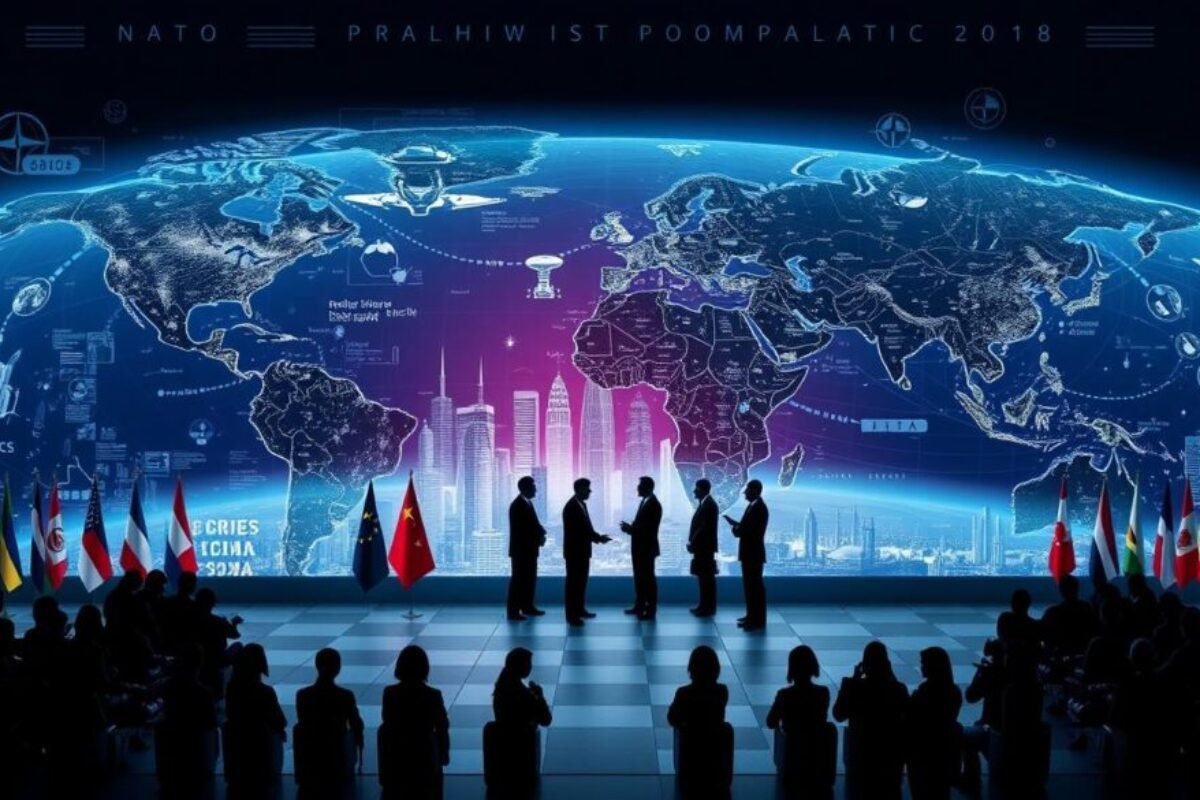Geopolitical Shifts & Alliances: U.S.–China tech war, BRICS expansion, NATO dynamics.
Did you know global investment in key technologies has jumped by over $500 billion in ten years? This huge increase shows the big changes happening in international power. These changes are not just about money; they affect global security and political alliances too.
The U.S.–China tech war, BRICS’ growth, and NATO’s changes are key players in reshaping world politics. Knowing about these shifts helps us understand the new world order. As we explore these, we’ll see how each part adds to a complex global scene.
Key Takeaways
- Global technology investments have soared by over $500 billion in a decade, signalling major shifts in international power dynamics.
- The U.S.–China tech rivalry shows the fight for tech control and global security influence.
- BRICS’ growth aims to create a world with more than one leader, challenging Western power.
- NATO’s changes help it face new threats and alliances.
- Understanding these shifts is key to getting the complex picture of global power changes.
Introduction to Geopolitical Trends
The world is changing fast, with new alliances and old power groups shifting. It’s key to grasp these trends to understand global politics. Superpowers are using tech, economy, and security to show their strength and influence.
New groups like BRICS are changing the world from Western control to a more balanced order. The U.S.–China tech war shows a fight for tech and economic power. These changes affect how countries relate to each other and how power is distributed.
Looking closer, we see both old and new powers adjusting their plans. They use tools like sanctions and military ties to stay strong. The next parts will dive into these changes, giving a full view of today’s world politics.
The U.S.–China Tech War
The U.S. and China’s growing tensions have deeply affected the tech world. This section explores the start and key moments of the tech war. It also looks at how it impacts the global supply chain and the importance of tech sovereignty and security.
Origins and Key Events
China’s fast growth in tech started the U.S.-China tech war. The U.S. banned Huawei and ZTE and later blacklisted Chinese companies. The U.S. also put limits on exporting semiconductor tech, hitting Chinese tech giants hard.
Impact on Global Supply Chains
The tech war has caused big problems for the global supply chain. Companies are now looking at their supply chains differently. They’re trying to find new sources and ways to make things to avoid problems.
This has led to new trade paths and partnerships. These are aimed at making supply chains stronger during the tech war.
Technological Sovereignty and Security Concerns
Technological sovereignty and security are big issues in the U.S.-China tech war. Countries want to control their tech and keep it safe. This means they’re focusing on making key tech at home.
The tech war also makes cybersecurity a big worry. Each side is trying to keep their tech and ideas safe from threats.
The tech war between the U.S. and China shows a bigger fight for power. It’s changing how we think about the economy, trade, and security. It’s important to understand this conflict to keep up with the fast-changing tech world.
BRICS Expansion: A New World Order?
The BRICS expansion marks a big change in global economic leadership. It shows a move towards a more balanced world order. Looking into why BRICS is growing, who joins, and what it means, we see it’s becoming a major world force.
Motivations Behind BRICS Expansion
BRICS wants to challenge Western power in global institutions. It’s growing to show the strength of emerging economies. This move aims to create a world where no one country or group has too much power.
New Members and Aspirants
Countries like Argentina, Indonesia, and Saudi Arabia want to join BRICS. They’re attracted by the chance for economic growth and strategic partnerships. Adding new members will make BRICS’s voice even stronger in global affairs.
Implications for Global Economic Governance
The BRICS growth will change how the world is run economically. With more power, BRICS can influence global finance more. This could lead to more equal decision-making, benefiting more countries. The rise of BRICS is a big deal for the future of our world.
BRICS and the Challenge to Western Dominance

BRICS is now a major force, pushing against Western dominance. In today’s world, where many powers matter, BRICS stands out. They are working to create a more balanced world, different from the old U.S.-led system.
Shift from U.S.-Led Unipolarity to Multipolarity
The world is moving from U.S.-led dominance to a more shared power structure. BRICS countries are at the heart of this change. They aim for a world where everyone works together, not just one power.
These nations are using their strength and resources to challenge the West. This change is real, seen in global meetings and economic projects.
Strategic Economic Cooperation within BRICS
BRICS focuses on working together economically. They want partnerships that help everyone and keep the world stable. Through trade deals, investments, and policies, they’re building a new world.
This teamwork not only strengthens their bonds but also shows a new way for others. BRICS is using its economic power to shape global rules, moving away from Western control.
NATO Dynamics in the 21st Century
NATO has changed a lot in the 21st century. It has faced new threats and changes in how countries relate to each other. This alliance, key for transatlantic security, has updated its plans and set up to tackle today’s challenges.
NATO now focuses on quick response teams ready to go anywhere fast. This shows NATO’s effort to stay important and strong in a world that’s getting more unpredictable. It also works on cyber defence and space security, as these areas are key for defence now.
Member countries work together more, making NATO stronger in defence and managing crises. This teamwork is key as threats come faster than before. NATO also partners with countries outside its group, making it more global and flexible.
The world is changing, with new powers and more global competition. NATO keeps focusing on security across the Atlantic and defending each other. Its path forward will depend on how the world changes and the unity of its members to protect their values and safety.
| Key Initiatives | Description | Impact |
|---|---|---|
| Rapid Response Forces | Deployment of forces at short notice globally | Enhanced operational readiness and flexibility |
| Cyber Defense | Strengthening network security and cyber capabilities | Protection against cyber threats |
| Space Security Initiatives | Developing defenses for space-based threats | Securing critical space infrastructure |
Geopolitical Flashpoints: Ukraine as a Proxy War
The Ukraine crisis has grown from a local issue to a global problem. It’s important to look at how it started and the role of NATO and the humanitarian effects.
The Evolution from Local Dispute to International Crisis
The Ukraine crisis began with local tensions and big ambitions. It turned into a global issue. The key moment was when Russia took Crimea in 2014, leading to international outrage and sanctions.
Clashes in Eastern Ukraine brought in many international players. This made the conflict more complex. It shows how a local fight can become a global war.
NATO’s Role and the Risk of Direct Confrontation
NATO’s role in Ukraine is a big issue. NATO has helped Ukraine with military aid and advice. But Russia sees this as a threat, raising fears of a big war.
This situation shows how delicate the balance of power is. A small mistake could lead to a big conflict, affecting peace worldwide.
The Humanitarian Impact of the Ukraine Conflict
The Ukraine conflict has had a huge impact on people. Millions have lost their homes, and many services are missing. The mental health of civilians is also suffering greatly.
Helping those affected is hard because of the fighting. The crisis shows the human cost of war.
Looking at the Ukraine crisis from all angles is key. We must understand the conflict’s growth, NATO’s role, and the human suffering. This gives us a full view of a major global issue.
Economic Warfare and Sanctions: Effectiveness and Consequences
Economic sanctions are a key tool in today’s world politics. They are used to pressure countries without war. But, how well they work is a big debate in global economics.
The geopolitical impact of sanctions is huge. For example, sanctions on Russia have made Europe’s energy supply tight. They’ve also changed alliances, with China looking to gain from the shift.
The world reacts differently to economic sanctions. Some say they can weaken aggressive states. But others worry about the bad effects, like human crises and market troubles.
The long-term success of economic sanctions depends on keeping them up. Without ongoing effort, their impact may not last or could even backfire.
Understanding the effects of sanctions needs a deep look at global economics. Here are some key points:
| Aspect | Consequences |
|---|---|
| Targeted Nation | Economic shrinkage, political isolation, possible regime change |
| Sanctioning Countries | Policy power, global influence, economic costs at home |
| Global Market | Disruptions in supply chains, market ups and downs, energy price swings |
In the end, the success of economic sanctions depends on global cooperation. It also needs a clear grasp of how countries are connected economically.
The Information War: Propaganda, Disinformation, and Public Opinion
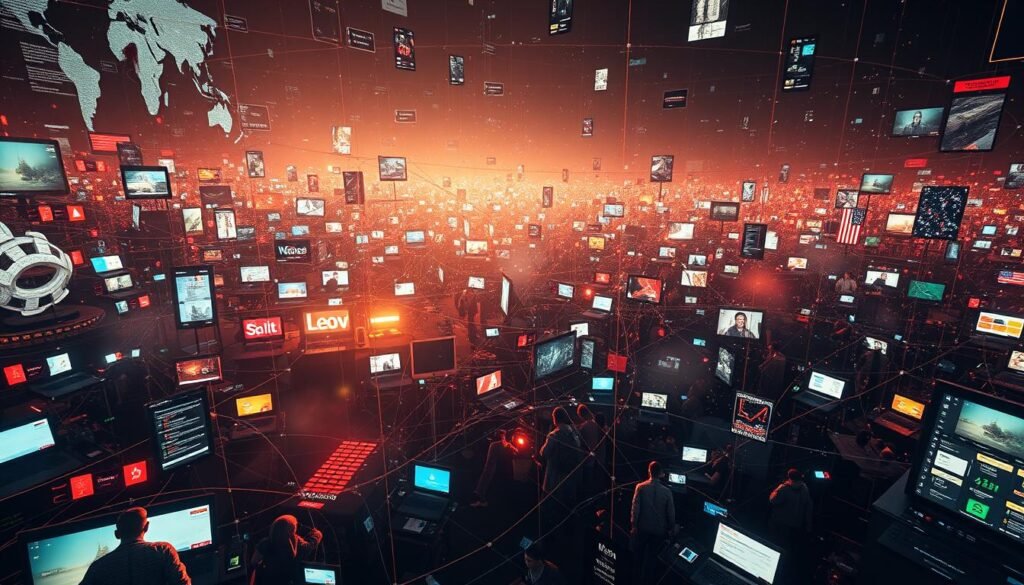
In today’s digital world, the *information war* plays a big role in global strategies. States and other groups use propaganda and disinformation to shape public opinion. They aim to change how people see and decide on global issues.
These tactics include messing with news, social media, and online activities to twist facts. They’re good at making public opinion fit certain political goals.
The *information war* happens everywhere online, from big news sites to small forums. It makes it hard to tell what’s true and what’s not. This leads to a lot of doubt and mistrust.
Many big conflicts and decisions show how powerful propaganda can be. For example, during elections, false info campaigns can hurt trust in democracy. This shows how info can be used to shape politics.
Here’s a look at how big powers use different *information war* tactics:
| Technique | Country | Objective | Impact |
|---|---|---|---|
| Social Media Bot Armies | Russia | Amplify specific narratives | Public opinion influence, disruption of electoral processes |
| State-Controlled Media | China | Promote state policies and discredit oppositional views | Enhanced national unity, international perception management |
| Alternative News Outlets | United States | Counter opposing narratives | Fostered distrust in mainstream media, polarized electorates |
It’s key to get how the *information war*, its propaganda tactics, and its effect on public opinion work. This helps us understand today’s global politics and their effects.
Strategic Alliances and Infrastructure Networks
In today’s world, strategic alliances and global infrastructure networks are key to influence. China’s Belt and Road Initiative, Japan’s Policy Program, and the EU’s new finance plan are big examples. They show how these efforts shape our world.
China’s Belt and Road Initiative
The Belt and Road Initiative (BRI) is China’s big plan. It aims to link Asia, Europe, and Africa with trade routes. China is working with many countries to boost economic ties and improve infrastructure.
Japan’s Policy Program for Promotion of Overseas Infrastructure Systems
Japan is also playing a big role through its policy program. It’s all about improving infrastructure abroad and strengthening alliances. Japan wants to grow its economy and help the world with better infrastructure and tech.
The EU’s Reconfigured Development Finance Architecture
The European Union has updated its finance plan to tackle global issues. It’s focusing on building strong alliances and using money wisely. The EU wants to help countries with sustainable projects and make a difference worldwide.
Here’s a quick look at these big plans:
| Initiative | Key Features | Primary Goals |
|---|---|---|
| Belt and Road Initiative | Extensive trade routes, diverse partnerships, infrastructure investments | Enhance connectivity, economic cooperation, geopolitical influence |
| Japan’s Policy Program | Quality infrastructure, technological advancements, economic diplomacy | Strengthen economic presence, establish robust alliances |
| EU Development Finance | Streamlined financial instruments, sustainable projects, collaboration | Utilize development finance effectively, foster global partnerships |
State-Capitalist Geopolitics in Technology and Manufacturing
The mix of state policies and capitalist actions is clear in tech and manufacturing. Countries are fighting for tech control through different plans and money investments.
Western Responses: The U.S. CHIPS Act and Beyond
The U.S. created the U.S. CHIPS Act to tackle tech challenges. It aims to boost home chip making to cut down on foreign reliance. The U.S. is pouring money into chip research and making to stay ahead in tech.
The U.S. CHIPS Act shows a trend of protecting national interests in tech. It tackles supply chain issues and strengthens alliances. This ensures a united effort in tech and manufacturing security.
China’s Technological Investments and Initiatives
China is also working hard to control its tech future. It’s investing big in AI, 5G, and chip making to lessen its tech dependence on the West. The “Made in China 2025” plan shows China’s goal to lead in tech.
Here’s a look at how the U.S. and China differ in their tech strategies:
| Aspect | U.S. CHIPS Act | China’s Initiatives |
|---|---|---|
| Main Focus | Semiconductor production | Broad spectrum: AI, 5G, semiconductors |
| Strategy | Domestic investment, alliances | State-led investments, domestic and international |
| Key Legislation/Initiative | U.S. CHIPS Act | Made in China 2025 |
| Funding Allocation | Semiconductor research and manufacturing | Advanced technology sectors |
In short, state-capitalist geopolitics is making countries focus on tech control. The U.S. CHIPS Act and China’s tech plans show a global tech race. This is changing how countries relate to each other.
Global Security Landscape: Military and Defense Alliances
The global security scene is more complex than ever. This is due to changes in military alliances and defense plans by major countries. Nations are adjusting to new geopolitical situations, focusing on defense agreements with others.
NATO is a key player, ensuring the safety of its members through shared defense plans. Article 5 is critical, saying an attack on one member is an attack on all. This shows NATO’s importance in keeping the world stable.
China is also making its mark on global security. It’s doing this through groups like the Shanghai Cooperation Organization (SCO) and partnerships with other countries. These moves not only grow China’s influence but also shake up the balance of power, making other countries rethink their defense plans.
The U.S. is also playing a big role in the Indo-Pacific region. The AUKUS pact between Australia, the UK, and the U.S. is a prime example. It aims to strengthen defense and counter threats in this critical area.
It’s important to look at the key military and defense ties:
| Alliance | Members | Key Strategy |
|---|---|---|
| NATO | 30 member states | Collective defense, deterrence |
| Shanghai Cooperation Organization (SCO) | 8 member states | Regional security, economic cooperation |
| AUKUS | Australia, UK, U.S. | Military technology, Indo-Pacific security |
This summary shows how the global security scene is always changing. It’s shaped by shifting military alliances and new defense strategies. Keeping up with these changes helps us understand the shifting balance of power worldwide.
Geopolitical Shifts & Alliances
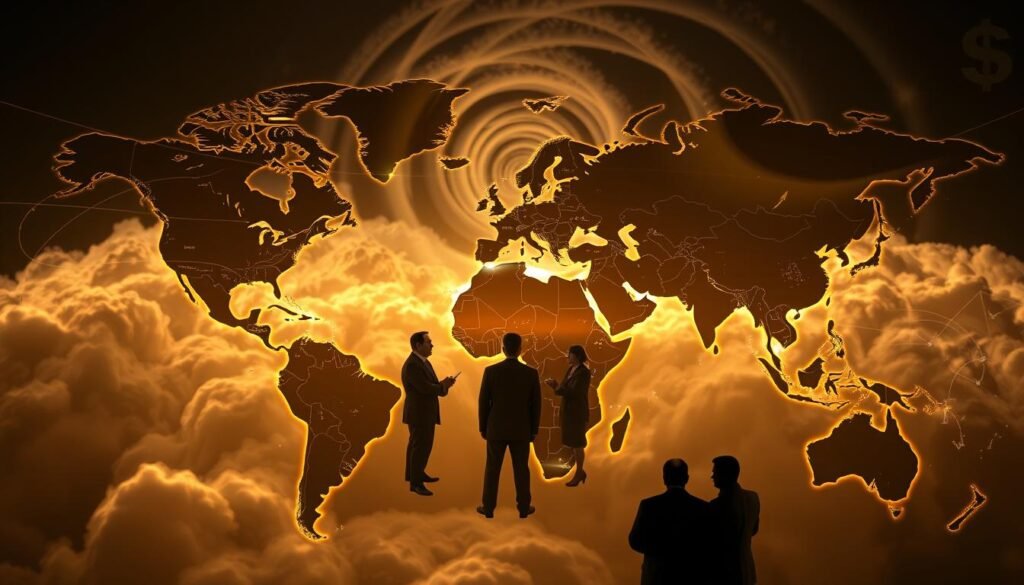
The world of global alliances is changing fast. Geopolitical shifts are reshaping how countries interact. BRICS and NATO are key players, along with the complex U.S.-China relations.
The Interplay between BRICS, NATO, and U.S.–China Relations
The relationship between BRICS and NATO is complex. The growing U.S.-China dynamics adds to the mix. Each group has its own goals and strategies, making the world more complex.
BRICS wants to challenge Western powers. NATO focuses on defending its members, worried about Russia and China. This change is making diplomats and economists rethink their plans.
Potential Long-Term Impacts on International Relations
The changes we see today will shape the future of international relations. BRICS is growing stronger, and NATO is adapting. This could lead to a world with more than one dominant power.
We might see different priorities, like economic growth or security. The future is uncertain but exciting.
| Geopolitical Entity | Primary Focus | Strategic Shift |
|---|---|---|
| BRICS | Economic Cooperation | Expanding membership and influence |
| NATO | Collective Security | Enhanced defense strategies |
| U.S.-China Relations | Technological and Trade Dominance | Ongoing tensions and strategic competition |
These changes are not just temporary. They show deep shifts in global power. The balance between BRICS and NATO and the U.S.-China dynamics will keep shaping our world.
Emerging Markets and their Role in Global Power Dynamics
The world is seeing a big change in power balance. Emerging markets like Brazil, India, and Indonesia are playing big roles. They are changing how power works globally.
Brazil’s Strategic Position
Brazil’s influence is growing. It’s one of the biggest economies in Latin America. It uses its natural resources and location to make its mark.
The country is focusing on farming and energy. This makes it important in trade and finance.
India’s Balancing Act
India is also making a big impact. It’s growing fast and is a key counter to China in Asia. India is building strong ties with the West and Russia.
This shows India’s smart way of dealing with global power shifts.
Indonesia’s Growing Influence
Indonesia is becoming a big player in Southeast Asia. It’s the biggest economy in the region. Its location and strong market attract investors.
Indonesia is active in groups like ASEAN. This shows it wants to help create a more balanced world.
Brazil, India, and Indonesia show how emerging markets are changing the world. They are helping make the world more balanced and multipolar.
Energy Security and Geopolitical Competition
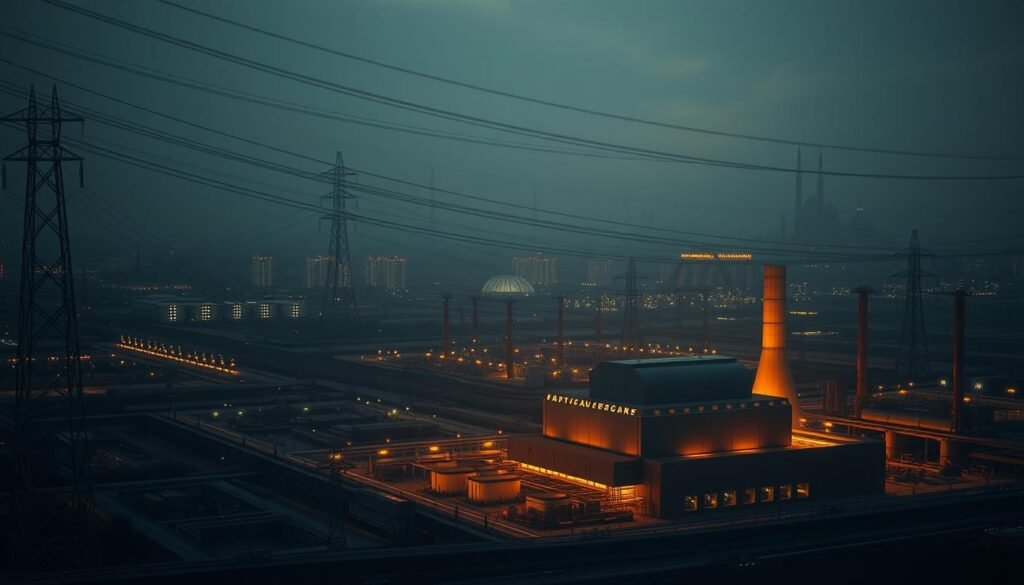
Energy resources play a big role in world politics. The BRICS nations—Brazil, Russia, India, China, and South Africa—are key players. They have lots of oil and gas and are growing their renewable energy. Knowing how these resources affect energy security helps us understand global power.
Oil and Gas Reserves: The BRICS Advantage
BRICS countries have a lot of the world’s oil and gas. Russia is a top oil producer, and Brazil’s oil fields are growing fast. These resources help keep their energy safe at home and give them an edge in the global market.
The vast reserves in BRICS countries not only ensure their domestic energy security but also provide a strategic advantage in international energy markets.
| Country | Oil Reserves (barrels) | Gas Reserves (cubic meters) |
|---|---|---|
| Russia | 80 billion | 48 trillion |
| Brazil | 12.7 billion | 15 trillion |
| China | 26 billion | 5.1 trillion |
Renewable Energy Initiatives within BRICS
BRICS nations are also focusing on renewable energy. China is leading with big investments in solar and wind. Brazil and India are growing their bioenergy and solar power. These efforts help secure energy and fight climate change.
The push for renewable energy in BRICS matches global efforts for cleaner energy. It’s key for lasting energy security and caring for our planet.
The Role of Sovereign Wealth Funds in Geopolitics
Sovereign wealth funds (SWFs) play a big role in financial geopolitics. These funds are managed by countries for strategic investments. They greatly affect the global economy.
Saudi Arabia and UAE’s Strategic Investments
Saudi Arabia and the UAE show how SWFs are used in financial geopolitics. Saudi Arabia’s Public Investment Fund (PIF) and the UAE’s Mubadala Investment Company invest in many areas. They put money into tech and clean energy to make their economies stronger and build global partnerships.
Norway’s Global Financial Influence
Norway’s Government Pension Fund Global is a huge SWF. It shows how SWFs can shape global finance. By investing in stocks and infrastructure worldwide, it helps the economy grow and supports sustainable development.
Technological Advancements and Geopolitical Rivalries
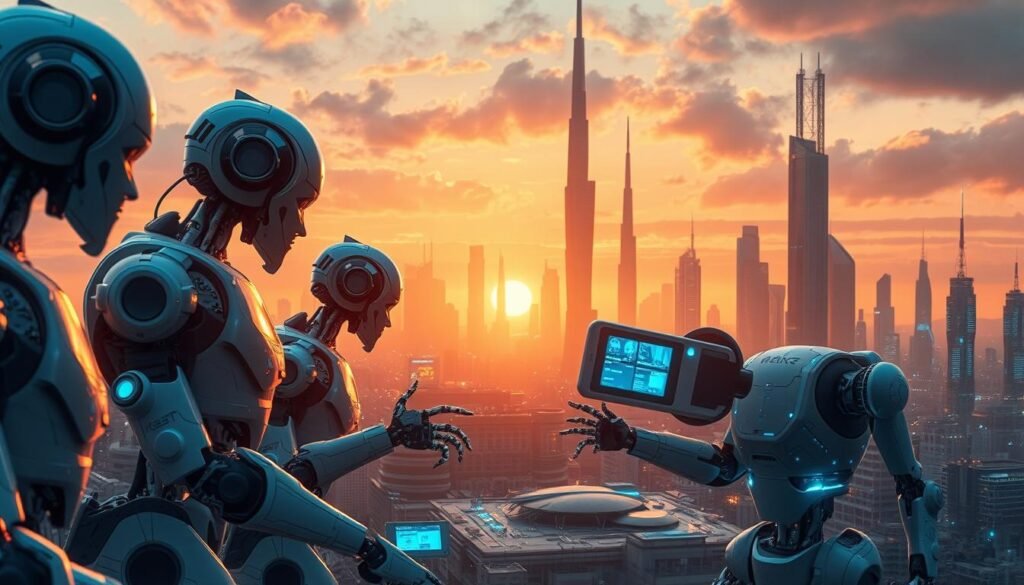
The race for technological supremacy is key in global power struggles. Nations are racing to lead, with major advancements in semiconductors and AI. These areas are critical in forming alliances and rivalries.
Semiconductor Supply Chain Dominance
Semiconductors are vital for today’s tech, from phones to military systems. The U.S. and China are leading the charge in this field. They’re investing in research and forming partnerships to control the supply chain.
Here’s a look at the top players in semiconductors and their strengths:
| Country | Major Companies | Technological Capabilities |
|---|---|---|
| United States | Intel, Nvidia | Advanced manufacturing, R&D excellence |
| China | SMIC, Huawei | Government backing, rapid scaling |
| South Korea | Samsung, SK Hynix | Memory chips, foundry services |
| Taiwan | TSMC | Leading-edge manufacturing, innovative processes |
Artificial Intelligence and Cybersecurity Concerns
AI and cybersecurity are vital in global rivalries. Nations are racing to develop AI for strategic gains. They’re also investing in cybersecurity to protect against threats.
AI in cybersecurity has led to better defenses. But, it also raises ethical and misuse concerns. Balancing AI for security and global cybersecurity is a delicate issue.
Trade Policies and Economic Integration
Trade policies are key in shaping economic integration and global trade. They set the rules for how economies work together worldwide.
Trade agreements are a big part of these policies. They cut down on trade barriers like tariffs and quotas. This makes trade smoother and more efficient.
Economic integration is more than just cutting trade barriers. It also means making sure everyone follows the same rules. This ensures fair competition and easy transactions across borders.
Trade policies have a big impact on global trade. For example, the USMCA has changed trade and economic ties in North America. The European Union’s Single Market has made trade and movement of goods and people easier in Europe.
Trade agreements are also used for geopolitical goals. They help countries build alliances and strengthen economic ties. This can lead to better political relationships.
| Trade Agreement | Participating Countries | Objectives | Impact on Economic Integration |
|---|---|---|---|
| USMCA | United States, Mexico, Canada | Reduce trade barriers, promote fair competition | Enhanced trade flows, economic collaboration |
| European Single Market | EU Member States | Free movement of goods, services, people, and capital | Deepened economic integration, unified market |
| Comprehensive and Progressive Agreement for Trans-Pacific Partnership (CPTPP) | Asia-Pacific countries | Promote economic integration, liberalize trade and investment | Increased trade complexity, regional economic growth |
In conclusion, good trade policies are vital for economic integration and global trade. By using these policies wisely, countries can build stronger economic ties and help the world prosper.
Conclusion
We’ve looked closely at how alliances, conflicts, and strategies are changing our world. The U.S.–China tech war and BRICS’ growing power show old power structures are changing. Our analysis shows a world where many powers matter, not just a few.
Technological progress and economic plans are driving these changes. They affect how countries act and interact globally. The battle for tech leadership and the use of economic tools like sanctions are key to understanding what’s next.
Looking ahead, the picture of global alliances is complex. These alliances are always shifting, requiring us to stay alert and flexible. With new players and strategies, our ongoing analysis is essential. It helps us stay ahead of the game and ready for what’s coming.
